The Linotype is a typecasting machine that was commonly in use from 1884 up to the 1980's for the production of lengthy texts, such as in books or newspapers.
The machine was invented by Ottmar Mergenthaler, a German watchmaker who moved to the United States in 1872. Soon thereafter, he started working on a machine that could speed up the setting of texts. In 1886, the first Linotype was introduced, the 'Linotype Blower'. This machine allowed typesetting via a keyboard, and it even sorted the matrices automatically back into a magazine.
Subsequently, in 1890, the 'New Linotype' was introduced. This machine already resembled all future Linotypes. From then on, several updates were made throughout the company's history. A full overview can be found on this page.
The Linotype meant a huge improvement over the hand set type as invented by Gutenberg. Through this development, it took less time to set a text. The machines were sold by the Mergenthaler Printing Company, later the Mergenthaler Linotype Company. The company marketed their product as the eighth wonder of the world, because it was deemed to increase overall literacy thanks to the increased production of reading materials.
The timeline below provides significant dates and events in the technical and business history of the development of composing linecasters. It starts with the pre-history of the Linotype. David MacMillan deliberately developed a detailed because too often these details have been ignored and history distorted.
1872-1876
Charles T. Moore works on various inventions, including a printing telegraph, a type-setting machine, and a type-writer. Some of this work is done with the support of James Ogilvie Clephane. A number of these are not clearly related even to the very early development of the Linotype. However, Moore's 1878 US patent 201,436 (filed 1877) was for a method of using paper strips either as transfer media for lithographic printing or impressed paper matrices for stereotype printing. This latter principle was used in Mergenthaler's Rotary Matrix Machine. This patent describes no machine, but just the method of paper strips. (It actually patents the process which would become known in the phototypesetting/offset lithography era as "paste-up"). For a more comprehensive study of Moore, see the CircuitousRoot Notebook on Charles T. Moore.
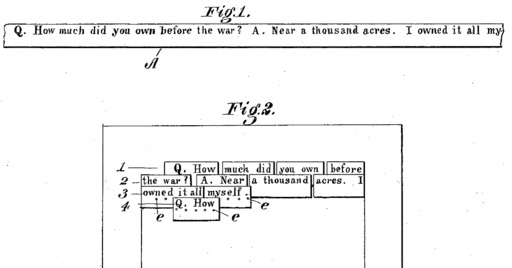
Figure: Patent 201,436 regarding a method of preparing transfer sheets or matrices for printing (Click to download).
1876 (July)
Moore changes the machine shop he is employing to that of August Hahl, in Baltimore. Hahl was Ottmar Mergenthaler's stepcousin. Mergenthaler joined Hall's shop in 1872 and "within two years" was shop foreman and part-time business manager. This introduced Clephane, Moore's backer, to Mergenthaler. Mergenthaler was involved in the construction of further versions of Moore's machines. By 1877, though, trials of this system had demonstrated insurmountable problems and it was abandoned. ( {Goble 1984}, p. 48. {Mergenthaler 1989}, pp 4-5.) I am aware of no surviving details or illustrations of any of the composing or lithographic transfer equipment constructed either by Moore prior to July 1876 or by Mergenthaler through 1877. The composing machine used might (or might not) have resembled Moore's 1872/1873 type-setting machine, Moore's 1873/1876 type-writer, or Mergenthaler's 1878 Rotary Impression Machine. All of these machines differed significantly from each other.
1878
Clephane asks Mergenthaler to build a machine using the alternative paper strip sterotype method specified in Moore's 1877/1878 patent (201,436). This was the "Rotary Impression Machine" ( {Goble 1984}, p. 51, {Huss 1973}, pp. 108-109, {Mergenthaler 1989}, pp 7-10.) Mergenthaler filed two patents for versions of this machine, though he did not do so until 1883 (US 304,272, issued 1884-08-26) and 1884 (US 328,960, issued 1895-10-27).
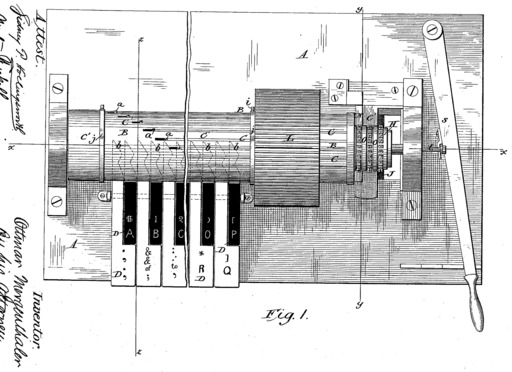
Figure: Patent 304,272 for a matrix making machine (Click to download).
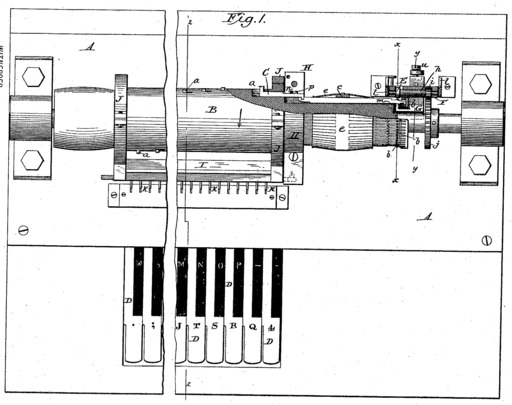
Figure: Patent 328,960 for a matrix making machine (Click to download).
As an aside it seems to me interesting that these two patents by Mergenthaler for the Rotary Impresssion Machine were filed in 1883 and 1884, some years after he lost interest in that machine. If you combine this with the fact that Moore filed his patent for slug-line casting in 1884 and that the whole project was abandoned by Clephane/Moore/Hahl in 1884, it seems to me very much like Clephane was acting to wrap things up and secure the rights to the technologies developed in the failed Rotary Impression Machine project just as he was moving on to Mergenthaler's First Band Machine.
1883
The machine below is commonly mistaken for that of 1878 (or 1876). Note that most illustrations purporting to be the "Rotary Matrix Machine" built by Mergenthaler are actually of a later (1883) machine that he did not construct. Here is an illustration of the 1883 version of this machine; Mergenthaler did not build this:
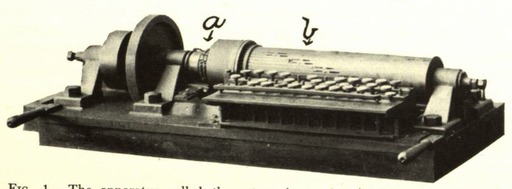
Figure: A machine commonly mistaken as developed by Mergenthaler (image from Bullen, 1924-02. Click to download).
1878? - 1883/1884
At some point the stereotype casting process used with the Rotary Impression Machine may have employed a method of casting stereotypes not as plates but rather as individual lines. Mergenthaler says that this occurred at the outset of the development of the Rotary Impression Machine (thus 1878), but he neither claims this idea for himself nor says who originated it. (Mergenthaler, 1989, p.8). Mergenthaler filed the first patent on this, but only in 1884 (US 311,350) after he had begun work on his First Band Machine. Moore filed a patent on a system much more in line with the work on the Rotary Band Machine, but he did this at the end of the continued developement of that machine in 1884. Both patents were assigned to the National Typographic Company (which became the Mergenthaler Linotype Company).
These "lines of type" were cast in their own equipment (not in a composing machine) from strip-paper stereotype matrices. Still, the use of a cast line of type is, tautologically, the core technology of the Linotype. See below for a discussion of the 1883 and 1884 patents.
1879 - 1884
Mergenthaler ceases direct work on the Rotary Impression Machine, considering "further efforts ... useless" ( {Mergenthaler 1989}, p. 10.), but Clephane, Moore, and Hahl continued to support development on it in a shop set up for this purpose. (Mergenthaler, 1989, p.10 and Goble, 1984, p.52). This work terminates (according to Mergenthaler) in 1884. the 1883 machine generally used to illustrate "Mergenthaler's Rotary Matrix Machine" dates from this period; Mergenthaler had no involvement with it.
1879
Mergenthaler, according to his own claim, conceives of the idea of impressing an entire paper stereotype matrix strip at once, using conventional type, but he destroys the uncompleted drawing for this in "a fit of anger." ( {Mergenthaler 1989}, p. 10.)
1882
Clephane brings Lemon G. Hine on board as another backer. They approach Mergenthaler to build a machine. ( {Mergenthaler 1989}, p. 11.)
1883
On January 1, Mergenthaler, who had by that time become a partner in Hahn's shop, dissolves that partnership and sets up his own shop to work on a machine for Clephane and Hine. This ended up as an impression machine producing paper stereotype strips one strip at a time. It did not employ regular types for this (as Mergenthaler had conceived in 1879) but rather a series of vertical bands each of which contained patrices (punches, essentially) for impressing the paper strip. These vertical bands were lined up, under keyboard control, to compose the line of text to be impressed. This machine has become known as the First Band Machine. Mergenthaler claimed that "a full-size working machine ... was brought to test as early as the fall of 1883." ( {Mergenthaler 1989}, p. 11-14.), Its patent, US no. 312,145, was filed 1884-07-12 and issued 1885-02-10. It was assigned to the National Typographic Company, a predecessor of what became the Mergenthaler Linotype Company. (Moore's patent for direct casting of slugs (see below) was also filed in 1884 and assigned to the National Typographic Company).
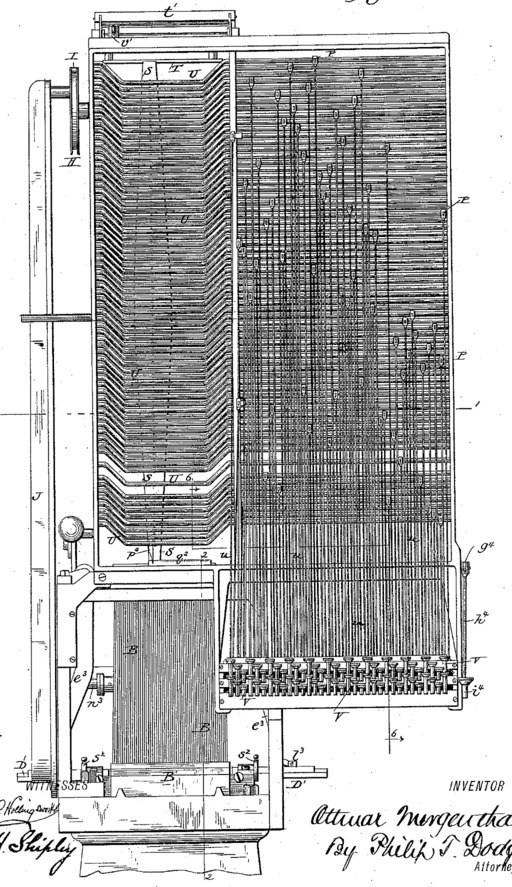
Figure: Patent 312,145 regarding a machine for producing stereotype matrices (Click to download).
1883 & 1884
There are two nearly simultaneous patents for the basic idea of casting an entire line of composed text (rather than individual types, on the one hand, or complete form/page-size steretype plates, on the other hand). From the point of view of contemporary patent litigation it doesn't matter which came first, since they were both assigned to the National Typographic Company, a predecessor of the Mergenthaler Linotype Company. (This was important as the litigation between the MLC and the Rogers Typograph Company in the 1890s hinged on the basis of priority for linecasting.) From the historian's point of view, of course, it matters quite a bit who first originated this idea. It is likely, however, that we will never know. Both involve casting from strip-paper stereotype matrices, and it is likely that the idea for this might go back as far as 1878 and the initial development of the Rotary Impression Machine . Mergenthaler himself says as much, although (as noted above) he does not take credit for this. (Mergenthaler, 1989, p.8.)
In terms of filing date, Mergenthaler was first, with US patent 311,350 filed 1883-03-12 and issued 1885-01-27. His system envisioned using the strip-paper matrices to cast long bars of type which are then cut into line-size slugs for assembly into a form or page. By the time he filed this patent, his development of the First Band Machine was well underway.
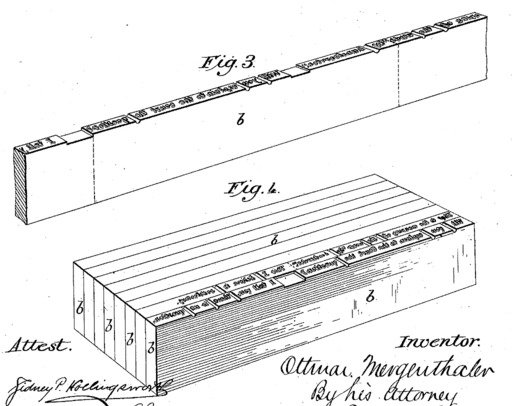
Figure: Patent 311,350 regarding a method of and means for producing printing surfaces (Click to download).
1884
Nearly a year later, on 1884-02-12, Moore filed the patent granted as US patent 362,987 (1887-05-17). for casting complete lines of type. By the time of this filing, work was terminating on the unsuccessful further development of the Rotary Impression Machine by Moore/Clephane/Hahl. Moore's patent was assigned to the National Typographic Company,
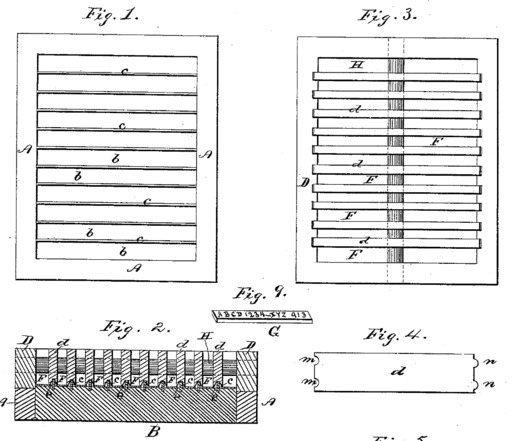
Figure: Patent 362,987 regarding a machine for producing printing bars (Click to download).
1883/1884
At some point in either late 1883 or early 1884, Mergenthaler conceived the idea of integrating the composition by means of vertical bands with the casting of slug lines of type in a single machine. (Mergenthaler said that this idea came to him during a train journey to Washington to consult with Clephane and Hine about the First Band Machine). This new idea required the use of bands with intaglio matrices rather than relief patrices (and of course the development of a casting mechanism). Mergenthaler reported that it was tested in July 1884, under the operation of Julia Camp. ( {Mergenthaler 1989}, pp. 15-16.), This machine has become known as the Second Band Machine. It was the first keyboard-operated linecasting machine. Its patent (US no. 313,224) was filed 1884-08-30 and issued 1885-03-03.
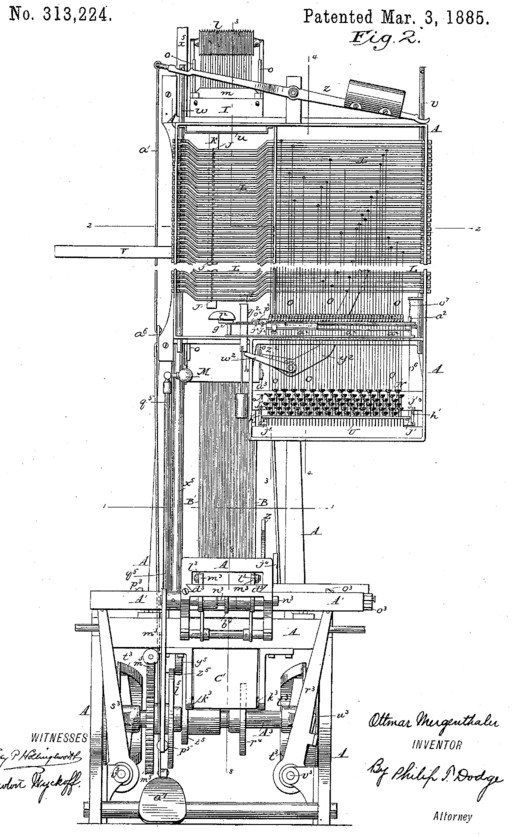
Figure: Patent 313,224 regarding a machine for producing printing bars (Click to download).
It is perhaps from the patent dates of the Second Band Machine that stories circulate that the Linotype was invented in 1884 or 1885, but this machine, while certainly a composing linecaster, did not yet embody all of the basic principles of the Linotype. It lacked a means of automatic line justification, and it lacked the principle of recirculating matrices.
1884/1885
Mergenthaler claimed that in 1883 he considered the problem of line justification and solved it by a wedge (he doesn't say double-wedge) method. This was not applied to the First Band Machine, but in 1884 he began to apply a double-wedge "space-bar" to the Second Band Machine. (Mergenthaler, 1989, p.17), He did not file a patent for it until 1885-04-17, however; this was issued 1886-07-13 as US patent 345,525. Unfortunately for the Linotype organization, this filing came 49 days after Jacobs W. Schuckers filed his double-wedge justification patent. (Goble, 1984, p.58). Schuckers' patent is US No. 474,306, filed 1885-02-27 but not issued until 1892-05-02. Despite attempts by Henry Lewis Bullen to allege the contrary, for the entire period of Linotype development through the commercial introduction of the Model 1 in 1892, Mergenthaler must have been unaware of any question to his own priority in the invention of the double-wedge spaceband.)
So no later than early-1885 the Second Band Machine with double-wedge space-bars was in engineering development. This machine was demonstrated in public in February 1885 (Mergenthaler, 1989, p.19), and it survives in the now mothballed Smithsonian collections.
1884
A trade note appears for the Benton, Waldo & Co. in The Inland Printer advertising the capability of cutting punches in steel by machine (Inland Printer 1.1). Mergenthaler and the Linotype organization remained unaware of this until 1887 or early 1888, well after the commercial introduction of the "Blower" Linotype.

Figure: Benton-Waldo punchcutter announcement (Click to download).
1884
Even though the Second Band Machine would be demonstrated in public in Feb. 1885, by 1884 Mergenthaler had decided that it was inadequate and had conceived of the idea of using individual matrices (rather than matrix bars) and recirculating those matrices within the machine (from a magazine, to assembly in composition, to casting, and then back to the magazine). (Mergenthaler, 1989, p.21; Goble, 1984, p.74-75) Mergenthaler took out three patents which showed complete recirculating matrix machines prior to the 1886 "Blower" Linotype.
Mergenthaler's first patent for a recirculating matrix machine was US patent no. 317,828, filed 1884-10-21 and issued 1885-05-12. It specifically references (and employs) the mold mechanism of the earlier Second Band Machine.
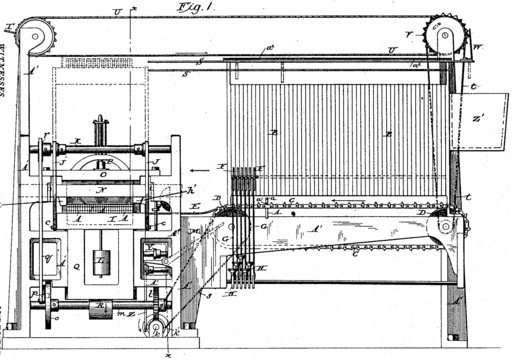
Figure: Patent 317,828 regarding a machine for producing printing bars (Click to download).
1885
Further development of the recirculating matrix machine. Mergenthaler's second patent showing a complete recirculating matrix machine was filed 1885-05-11 as application serial number 165,138. Issued 1886-07-13. This machine shows a distinctive flared style of magazine tubes (not used in any production machine).

Figure: Patent 345,526 regarding a machine for producing type bars (Click to download).
Neither of the machines shown in patents 317,828 and 345,526 incorporates the "Combination Teeth" by which the matrices were suspended from, and sorted by, a Distributor Bar in later machines.
The third patent is US 347,629, filed 1885-10-23 as appplication serial number 181,169 and issued 1886-08-17.
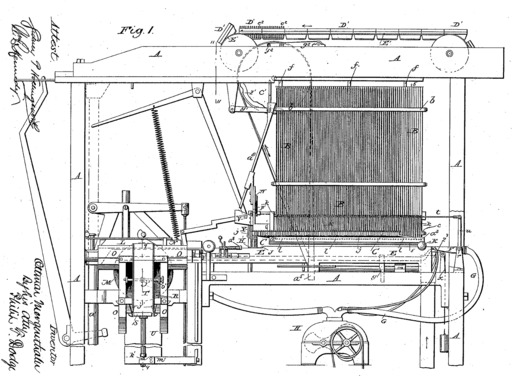
Figure: Patent 347,629 regarding a machine for producing type bars (Click to download).
This patent is interesting for several of its details.
First, it does show matrix Combination Teeth and a corresponding Distributor Bar. However, the pattern of rails on the Distributor Bar is not yet binary; it is an ad hoc pattern.
Second, this patent also contains one of those tiny details which escape the attention of the casual observer of the Linotype but are nonetheless indicative of its brilliant engineering: the Bar Point Slot which allows exactly one matrix at a time to be lifted by the Distributor Box onto the Distributor Bar, regardless of the widths of the various matrices. (page 6, lines 101-130).
Finally, the patent does not mention in its text anything about the construction of the casting cavities of the matrices, but the illustrations shown certainly suggest the use of electroformed matrices. While electroformed matrices remained common for other kinds of typographical casting machinery, their early use in the Linotype seems to have been forgotten until Carl Schlesinger reverse-engineered it. (See the appendices to {Mergenthaler 1989})
The machine as shown in 347,629, however, lacks the Second Elevator (one of the most visible features of the Linotype).
1885
This principle of recirculating matrices, together with the casting of a single slug-line of type and automatic justification with the double-wedge spaceband, completed the trio of ideas which constitute the basis of the Linotype. By 1885, all of these were in place in experimental machines. Intellectual credit for casting the slug-line of type is unclear, and may be shared by Mergenthaler and Moore Credit for integrating slug-line casting into a composing machine goes to Mergenthaler (the Second Band Machine). Mergenthaler and Schuckers more or less simultaneously, but independently, invented the double-wedge spaceband (Shuckers' didn't actually look much like a Linotype spaceband). To the best of my knowledge to Mergenthaler alone goes the credit for the concept of recirculating matrices.
In his (auto)biography, Mergenthaler illustrates a developmental machine with recirculating matrices dated to 1885. ( {Mergenthaler 1989}, p. 23) (I presume that this is the machine Huss lists as the "First Circulating Matrix Machine" (his catalog. no. 101; {Huss 1973}, p. 116.) This machine resembles the one shown in his US patent 347,629, shown above.
1886
The "Blower" Linotype. The first machine to enter production was the model which has since been called the "Blower" Linotype (because it used an "air blast" to move its matrices to the assembler). ( {Huss 1973}, p. 116, {Goble 1984}, pp. 75-84) It entered production at the New York Tribune in July 1886. ( {Mergenthaler 1989}, p. 27; this edition by Schlesinger also reproduces in facsimile the first page which contained material set by Linotype.)
The "Blower" Linotype does not have a Second Elevator. Its First Elevator carries the matrices from the casting position up to the Distributor. This is possible because it has a vertical "magazine" (not yet a removable magazine, but a series of tubes). The second elevator allows (and was required by) the adoption of inclined magazines on the Square Base Linotype of 1890. This machine does, however, have a recognizably modern spaceband box.
The patent for this machine is US patent 378,798, issued 1888-02-28 (filed 1886-07-17, with a complex foreign filing history).
Note: It would appear from Mergenthaler's remarks in this patent that characteristics of the magazine arrangement of this machine which were not present either in earlier developmental versions with uniform-tube-length magazines or in the later Square Base and subsequent machines with inclined magazines led to the adoption of the "etaoin shrdlu" order for the magazines and therefore the keyboard. For a discussion of this, see the CircuitousRoot Linotype FAQ.
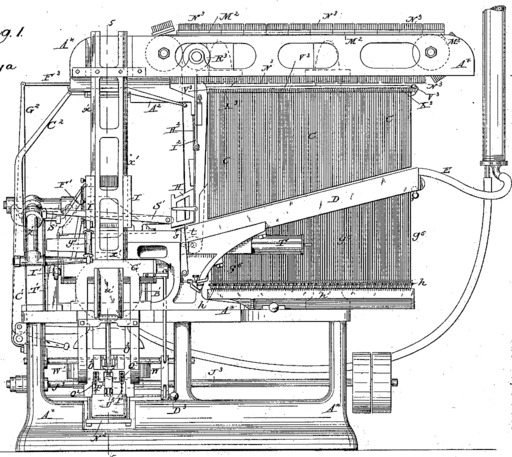
Figure: Patent 378,798 regarding a machine for producing type bars (Click to download).
So by 1886 it is reasonable to say that the Linotype "had been invented" because a machine was in limited production which contained all of the basic principles of the Linotype. However, it still had to undergo further development before it really became successful.
1887
The first documented use of the word "Linotype," in a "folder" entitled "The National Typographic and Mergenthaler Printing Companies." Its first use in a patent was in Mergenthaler's US patent 425,140 (filed 1888-01-19, issued 1890-04-08). ( {Goble 1984}, pp. 81, 103.)
1888
The first documented indication that the Linotype organization was now aware of the Benton, Waldo punch-cutting machine. On 1888-01-10Whitelaw Reid writes to Mergenthaler: "Please send on to the above address [Benton, Waldo & Co. in Milwaukee] at least 100 steel blanks fo the proper size for cutting a long primer or a small pica face." ( {Kahan 2000}, p. 48.)
1888
On 1888-01-19, Mergenthaler files what will be issued as US patent 425,140 (issued 1890-04-08) for improvements in the Blower Linotype.
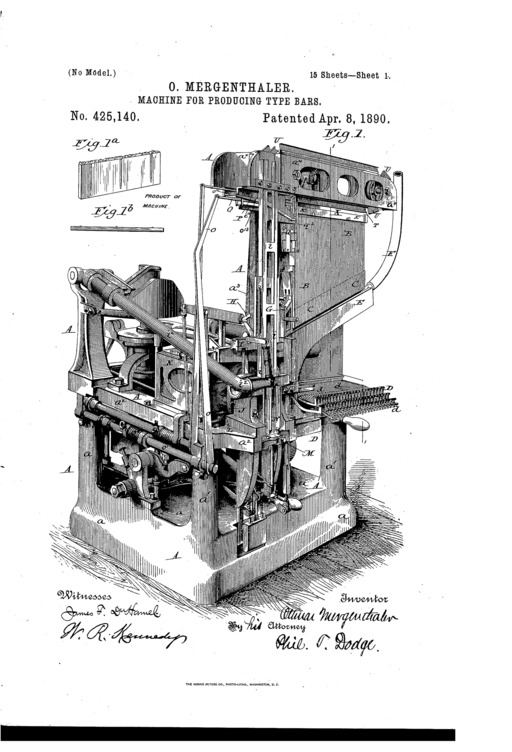
Figure: Patent 425,140 regarding a machine for producing type bars (Click to download).
1888
Mergenthaler resigns from the Linotype organization (March 15; resignation accepted April 4). ( {Kahan 2000}, pp 54, 56.)
1888
Mergenthaler begins work on the machine which will follow the Blower Linotype. ( {Goble 1984}, p. 88) This work is done by Mergenthaler in Baltimore, with some new financing by Clephane and others, not by the Mergenthaler Printing Company in Brooklyn. ( {Kahan 2000}, pp. 66, 68)
1888
Matrix making begins in a small shop in Brooklyn; this is before the acquisition of a Benton machine. ( {Kahan 2000}, p. 53, citing Whitelaw Reid's 1888 company report.)
1888
Amid considerable managerial confusion at the Linotype company, it closes its original Brooklyn assembly and matrix plants and reopens them in another location, closing their Baltimore plant and removing to Brooklyn their material from it. Meanwhile, and independently, Mergenthaler sets up another shop on his own in Baltimore. ( {Kahan 2000}, pp. 59 (Brooklyn closes), 61-64 (Mergenthaler in Baltimore), 66 (new Brooklyn plant).
1889
On February 13, 1889, the Mergenthaler Printing Co. leases its first Benton Punch Engraving Machine for its direct use. ( {Rehak 1993}, p. 109.) This was sent to Brooklyn and the Mergenthaler Printing Company, not Baltimore and Ottmar Mergenthaler & Co.
1889
Whitelaw Reid resigns from the presidency of the Mergenthaler Printing Company, February 1889. Hine succeeds him. Ottmar Mergenthaler resumes a relationship with the Mergenthaler Printing Company ( {Kahan 2000}, pp. 72-73, 75-76.)
1889
The patent that Mergenthaler filed on 1889-03-15 (issued 1890-09-16 as 436,531) is a perfect evolutionary missing link. Recall that the initial recirculating matrix machines up to the Blower Linotype had vertical magazine tubes. This led, Mergenthaler felt, to a danger of damaged matrices as they dropped in the tubes. With the Blower Linotype, he introduced a slanting assembly channel and, above it, magazine tubes of decreasing length. When used with the "etaoin" magazine/keyboard layout introduced to complement this mechanical arrangement this allowed the tubes which would be less full to be shorter (located on the right) and therefore to have a shorter matrix drop. With the machine which evolved into the Square Base, Mergenthaler solved this problem in a different way, by inclining the magazine itself. Friction would slow the matrices and eliminate the chance of damage. But this led to a problem. In the Blower Linotype (and earlier recirculating matrix machines) the First Elevator could raise the matrices directly up to the Distributor (because the magazine tubes were vertical). With an inclined magazine, the distributor was now located at the back of the machine, not directly above the First Elevator. In the machine as described in this patent, Mergenthaler kept the full travel of the First Elevator up to the Distributor level, but then added a means to convey the matrices back to the Distributor. It's a machine halfway between the Blower and the Square Base Linotypes.

Figure: Patent 436,531 regarding a machine for producing type bars (Click to download).
1889
Patent for "Square Base" Linotype. US patent 436,532, "Machine for Producing Lnotypes, Type-Matrices, &c." Filed 1889-11-11 as application serial number 329,908. Issued 1890-09-16 to Ottmar Mergenthaler.
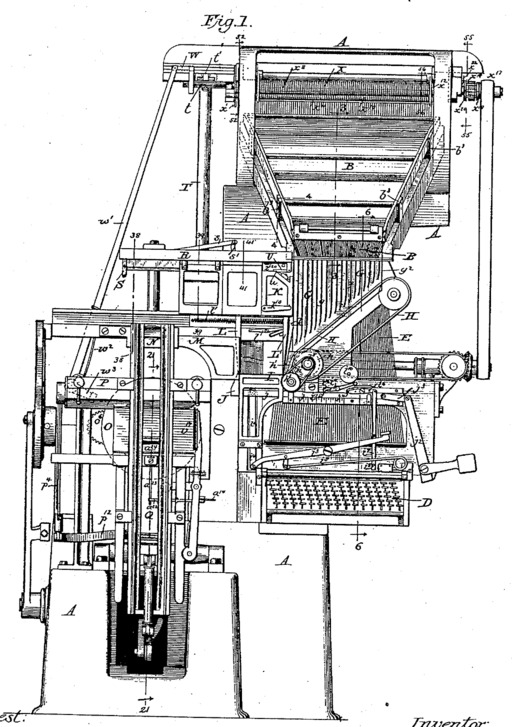
Figure: Patent 436,532 regarding a machine for producing type bars (Click to download).
1890
Last "Blower" Linotype built, at the Brooklyn factory (total number of machines built: 212). ( {Goble 1984}, p. 87.)
1890
"Square Base" Linotype introduced. Except for the structural shape of the machine frame, this was a Linotype in its modern form. Kahan reprints a letterhead from the Mergenthaler Printing Company, "Makers of the Linotype," dated 1890-11-24 which depicts a Square Base Linotype. ( {Kahan 2000}, p. 83.)
1891. The Mergenthaler Printing Company reorganized as the Mergenthaler Linotype Company. Hine resigns in December and is succeeded by P. T. Dodge. ( {Kahan 2000}, pp. 94-96.)
1892. Introduction of the "Model 1" Linotype (aka "Simplex" Linotype) The mechanism of the Square Base Linotype together with the more elegant "star" base.
Ottmar Mergenthaler died in 1899 at the age of 45 years.
The Mergenthaler Linotype Company kept improving the Linotype machines. The later models produced in America are described here. Please note that companies on other countries were set up. They produced different versions of the Linotype. Also, other companies such as Intertype and Linograph started producing their own linecasting machines. The overview can be found on the main page.
This timeline was originally written by David MacMillan and adjusted by Maarten Renckens.
Note: Several secondary sources are particularly reliable - notably {Huss 1973}, {Goble 1984}, and {Kahan 2000}. But even they may err when they rely upon unreliable earlier sources - notably Henry Lewis Bullen.
C 2021-2024 Maarten Renckens and other contributors. All rights reserved. All materials on this website are available for non-commercial re-use, as long as the original author is mentioned and a correct reference to this site is added. Thanks!
All materials are considered copyrighted by the author(s) unless otherwise stated. Some materials from other sources are used. If you find materials on this page which you consider not free from copyright, a notification is appreciated.
All collaborations and additional sources are more than welcome. Please contact info@maartenrenckens.com if you have materials that you deem valuable.